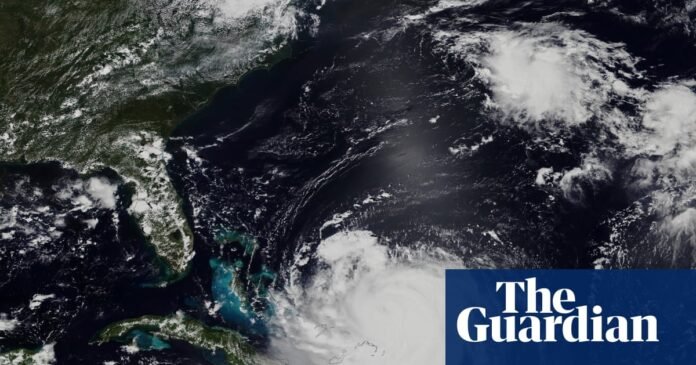Hurricane Erin remained far out at sea on Tuesday, yet it was still producing huge swells, with waves towering 20ft (6 meters) or more and crashing across sand dunes along North Carolina’s barrier islands.
The storm was tracking northward, running roughly parallel to the east coast, according to the US’s National Hurricane Center (NHC) in Miami. Though not projected to strike the mainland, Erin is expected to expand in size and generate hazardous rip currents in the upcoming days.
Officials in North Carolina’s Outer Banks warned of coastal flooding, prompting evacuation orders.
Erin became the Atlantic’s first hurricane of 2025, intensifying rapidly to a category 5 on Saturday before weakening. It then regained strength, knocked out power to more than 147,000 utility customers in Puerto Rico, and finally dropped to category 2 status on Tuesday morning.
The storm had sustained winds of 110 mph while moving north-west at 7 mph. Its center was located about 665 miles south-west of Bermuda and 720 miles south-south-east of Cape Hatteras, North Carolina.
The storm’s rapid growth ranks it among the fastest-intensifying hurricanes ever observed in the Atlantic, highlighting scientists’ warnings that the climate crisis – driven by greenhouse gas emissions caused by humans – is fueling more rapid storm strengthening.
Category 2 hurricanes carry sustained winds of 96 to 110mph. Erin was just shy of category 3, the threshold for what forecasters call a “major” storm that is capable of severe destruction, with winds starting at 111mph.
Even without a direct hurricane warning, Hatteras and Ocracoke islands were ordered to evacuate. Officials fear that North Carolina state highway 12 (NC 12), the narrow route linking the communities, will be heavily damaged or swept away, leaving residents isolated for days or even weeks.
In the Outer Banks, roughly 3,500 locals are accustomed to occasional cutoffs from the mainland – but the tens of thousands of tourists currently visiting are not.
“We haven’t seen waves of that size in a while and the vulnerable spots have only gotten weaker in the past five years,” Reide Corbett, executive director of the Coastal Studies Institute, told the Associated Press.
“Water, water everywhere. That really resonates on the Outer Banks,” Corbett said.
The northern areas around Nags Head and Kill Devil Hills, home to the region’s densest development, are outside the evacuation zone. But to the south, across Oregon Inlet, lies Hatteras Island, which relies solely on NC 12 for access. Beyond that is Ocracoke Island, which can only be reached by plane or ferry.
Highways were first built there more than six decades ago. Since then, the remote fishing communities transformed into a booming tourist destination, now dotted with thousands of oversized vacation homes.
after newsletter promotion
When storms strike, ocean and sound waters often breach dunes, burying the road under sand and debris. Severe events can tear apart pavement or carve out entirely new inlets, forcing temporary bridges.
Throughout the 2010s, the North Carolina department of transportation spent more than $1m annually just to keep NC 12 open, plus roughly $50m over the decade for storm-related repairs.
Despite the expense, Dare county generates about $2bn annually from tourism, ensuring that the cycle of rebuilding continues. But repairs are not quick. Hurricanes Isabel in 2003 and Irene in 2011 both created new inlets that required two months of ferry service until bridges were installed.
Rising sea levels, driven by climate change-related warming temperatures and melting ice, add to the danger. With much of the Outer Banks only a few feet above sea level, even minor erosion can have major effects, such as in Rodanthe, the community that juts furthest into the Atlantic.
Since 2020, more than a dozen homes in Rodanthe have collapsed into the sea. Authorities believe at least two more vacant houses could be lost if Erin’s surf is as intense as predicted.
The Associated Press contributed reporting





